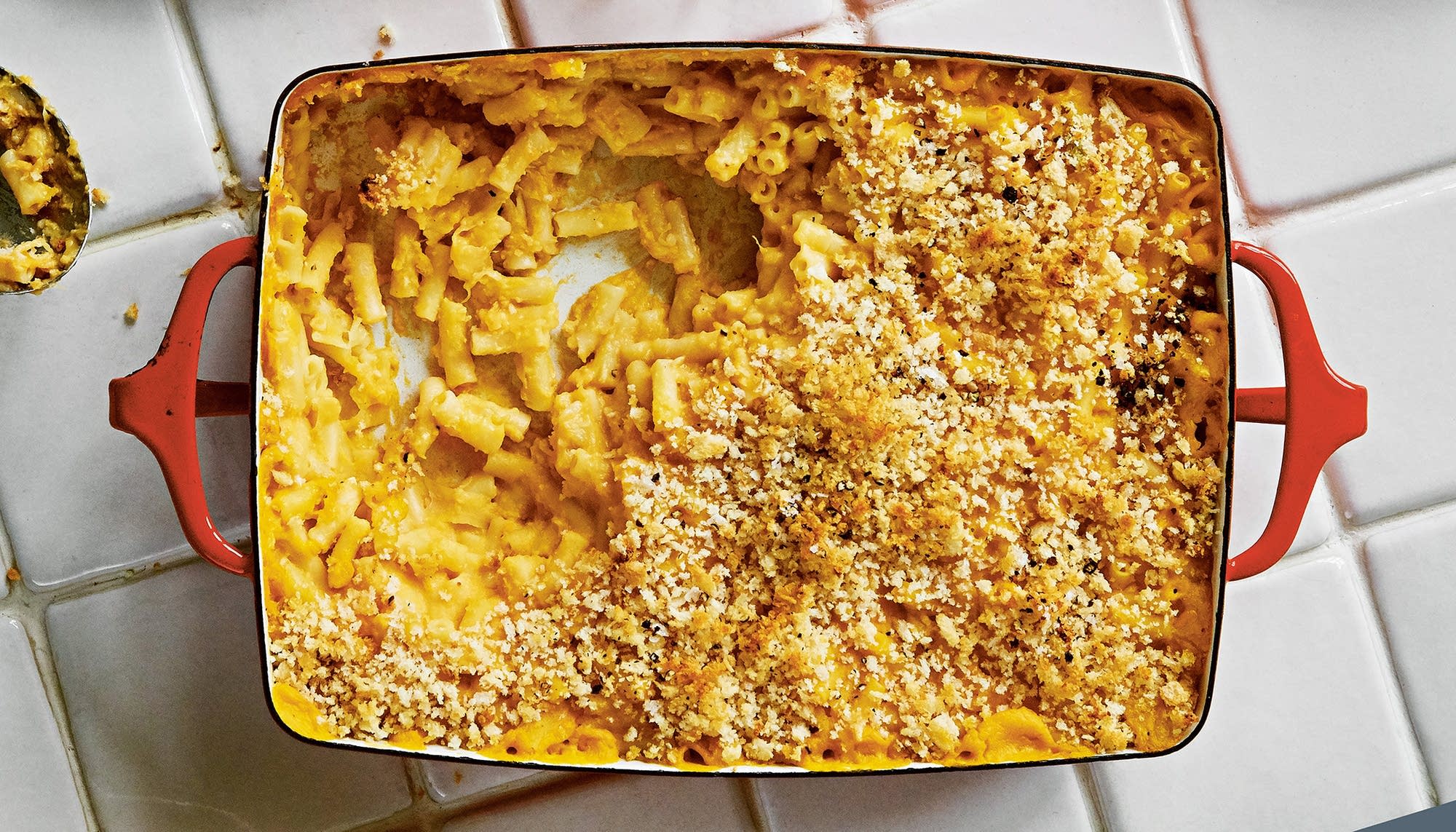
Pickled cabbage may seem like a strange ingredient to add, but it lends this dish a subtle lactic tang—we got the idea from Isa Chandra Moskovitz, a blogger whose recipe for mac and ’shews (cashews) is widely loved.
Ingredients
1/3 cup almond meal
1/3 cup water
1 cup peeled and coarsely chopped white potatoes
2 cups peeled, seeded, and coarsely chopped squash
1 carrot, peeled and coarsely chopped
12 1/2 oz small pasta tubes, such as macaroni or spirali (not quick-cooking macaroni)
2 tablespoons olive oil
2 tablespoons all-purpose flour
2 cups unsweetened dairy-free milk (not soymilk to keep it SoF), plus extra to taste
2 teaspoons nutritional yeast, plus extra to taste
2 teaspoons dry English mustard, plus extra to taste
1 teaspoon garlic powder
a really large pinch of sea salt
a large pinch of freshly grated nutmeg
1/4 cup sauerkraut or pickled cabbage
a lot of white pepper
neutral cooking oil, for greasing
FOR THE TOPPING:
2 slices of slightly stale bread
1 clove of garlic
a pinch of sea salt
1 tablespoon olive oil
 Leon Fast Vegan
by Rebecca Seal, Chantal Symons & John Vincent
Leon Fast Vegan
by Rebecca Seal, Chantal Symons & John Vincent
Directions
1. Preheat the oven to 400ºF. Mix the almond meal and water together and let soak.
2. Cook the potatoes, squash, and carrot in a saucepan of boiling water for 10 minutes, until just tender. Drain.
3. Meanwhile, cook the pasta in a separate saucepan of boiling salted water for 3 minutes less than the package directions. Drain.
4. While the vegetables and pasta are cooking, process the bread and garlic clove in a food processor to create bread crumbs for the topping. Toss the crumbs in the oil, then transfer to a bowl, and wipe out the food processor bowl.
5. To make a white sauce, heat the oil in a large saucepan over medium heat. When hot, add the flour. Reduce the heat low and cook, stirring, for a couple of minutes to form a paste (don’t let it brown). Gradually add the milk, a couple of tablespoons at a time, until about half has been incorporated, then stir in the rest of the milk. Cook, stirring, for 5 minutes. At this point, the sauce will be loose.
6. Working in batches, if necessary, put the vegetables into a food processor (or use a high-power blender) and add the white sauce, yeast, dry mustard, garlic powder, salt, nutmeg, sauerkraut, pepper, and soaked almond meal. Process until completely smooth, scraping the sides down twice. (A high-power processor or blender should make the sauce smooth, so keep going until this happens.)
7. Taste the sauce and add more mustard, pepper, yeast, or salt, if needed. It should be tangy, cheesy, and creamy. Stir into the drained pasta. If dry, add more milk to loosen, remembering it will thicken when it cooks. Transfer to a large greased gratin dish and sprinkle over a thick layer of the bread crumbs. Bake for 20 minutes, or until the sauce is bubbling and the top is golden brown. (To reheat from frozen, place the leftover mac in an ovenproof dish. Add a splash of unsweetened dairy-free milk. Cover with aluminum foil and cook for 10 minutes in an oven heated to 400ºF, then remove the foil and cook for another 5–10 minutes, until the top has crisped up again.)
TIP
Some food processors and blenders have a maximum fill point for blending hot food—ignoring it can make them explode, so process the sauce in batches, if necessary. If you taste the sauce and it doesn’t have enough savory tang for you, try adding 1/2 teaspoon—to start with—vegan Worcestershire sauce, miso paste, or Maggi liquid seasoning. Add any extras a little at a time, tasting as you go. Pimp your mac by adding sliced jalapeños, sweet smoked paprika, vegan chipotle paste, cooked and squeezed out spinach, or fake bacons, chopped.
Recipe excerpted from Leon Fast Vegan by Rebecca Seal, Chantal Symons & John Vincent. Copyright 2019 Hachette Book Group.
Before you go...
Each week, The Splendid Table brings you stories that expand your world view, inspire you to try something new and show how food brings us together. We rely on you to do this. And, when you donate, you'll become a member of The Splendid Table Co-op. It's a community of like-minded individuals who love good food, good conversation and kitchen companionship. Splendid Table Co-op members will get exclusive content each month and have special opportunities for connecting with The Splendid Table team.
Donate today for as little as $5.00 a month. Your gift only takes a few minutes and has a lasting impact on The Splendid Table and you'll be welcomed into The Splendid Table Co-op.



